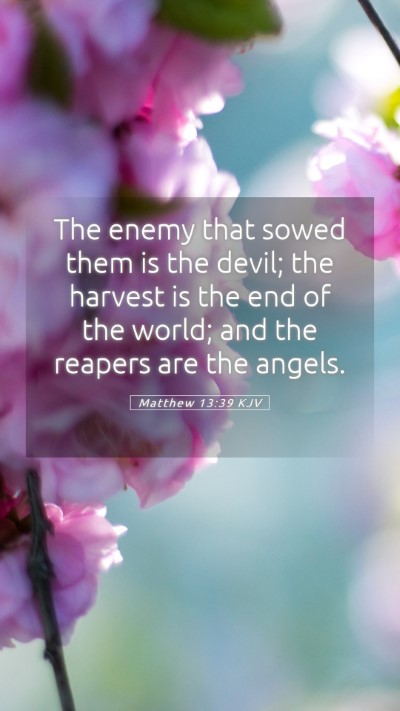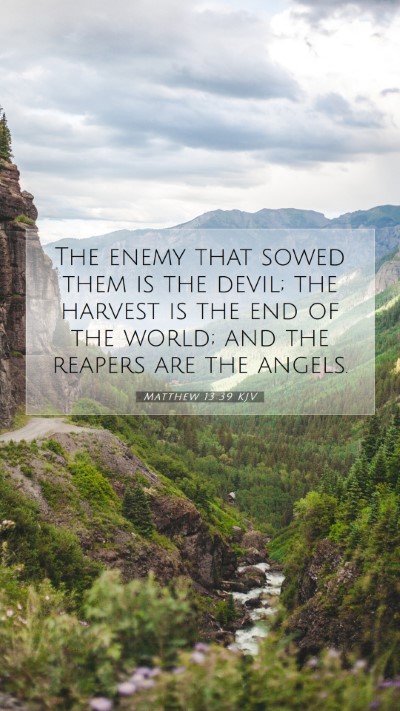Understanding Matthew 13:39
Bible Verse: "The enemy who sowed them is the devil. The harvest is the end of the age, and the reapers are angels." - Matthew 13:39
Overview of Matthew 13:39
This verse is part of Jesus' parable of the wheat and the tares (weeds), which illustrates the coexistence of good and evil in the world until the final judgment. It emphasizes the ultimate accountability of both the righteous and the wicked.
Biblical Exegesis and Commentary
Combining insights from esteemed public domain commentaries, we can derive a deeper understanding of this scripture.
Matthew Henry's Commentary
Matthew Henry notes that the "enemy" signifies the devil, highlighting the active role that evil plays in sowing discord among humanity. This commentary emphasizes that the devil's effort is to corrupt God's creation through sin and deceit. Henry further explains that the "harvest" serves as a metaphor for the final judgment when God will separate the righteous from the unrighteous.
Albert Barnes' Notes
Albert Barnes expounds on the symbolic meaning of the "reapers" as angels. He interprets their role as agents of God's judgment, tasked with gathering the wheat (representing the righteous) and burning the tares (the wicked). Barnes elaborates on the significance of this separation, reflecting God's justice and the certainty of divine retribution, reminding the audience that judgment day is inevitable and demands personal accountability.
Adam Clarke's Commentary
Adam Clarke provides additional insight by discussing the cultural and agrarian context of wheat and tares. He notes that these plants look remarkably similar until harvest, which serves as a poignant reminder that appearances can be deceiving. Clarke emphasizes that discernment is crucial, echoing the theme of vigilance against the devil's schemes. He underscores the ultimate triumph of God over evil, assuring believers of their vindication in the coming age.
Key Themes in Matthew 13:39
- Conflict between Good and Evil: The verse encapsulates the ongoing struggle between divine goodness and satanic malice.
- The Role of the Devil: It reminds readers that the enemy (the devil) actively seeks to undermine God's word and plan.
- The Final Harvest: It signifies the end of days when God will separate the righteous from the wicked for eternal destinies.
- Angelic Involvement: The angels, depicted as reapers, demonstrate God's authority and the role of celestial beings in executing His will.
Application of Matthew 13:39
Understanding this verse allows believers to navigate the complexities of life in a world filled with both righteousness and sin. It encourages them to remain steadfast in faith, to avoid complacency, and to actively participate in the work of the Kingdom.
Related Bible Verses
- Matthew 25:31-32: Referring to the final judgment when the Son of Man separates the nations.
- John 8:44: Discussing the devil as a liar and the father of lies.
- Revelation 14:15: Depicting the day of harvest when God's judgment is fulfilled.
Conclusion
Ultimately, Matthew 13:39 serves as a powerful reminder of the reality of spiritual warfare, the certainty of divine judgment, and the importance of discernment in the Christian life. By studying and understanding this scripture, believers can gain valuable insights into the nature of good and evil and the assurances of God's justice.


